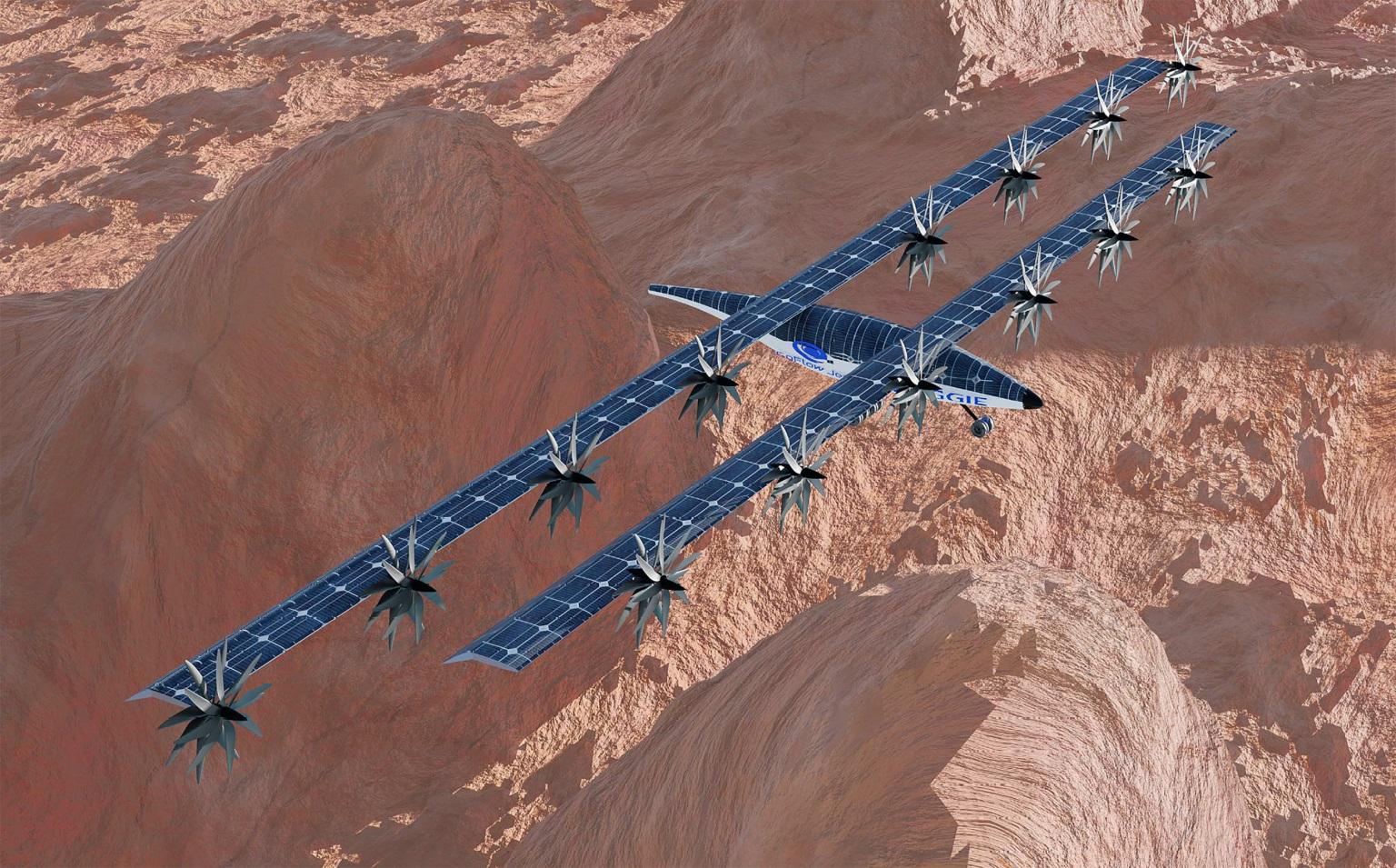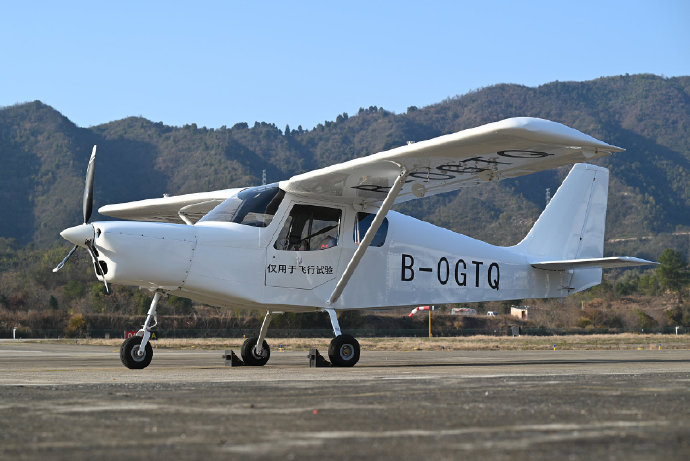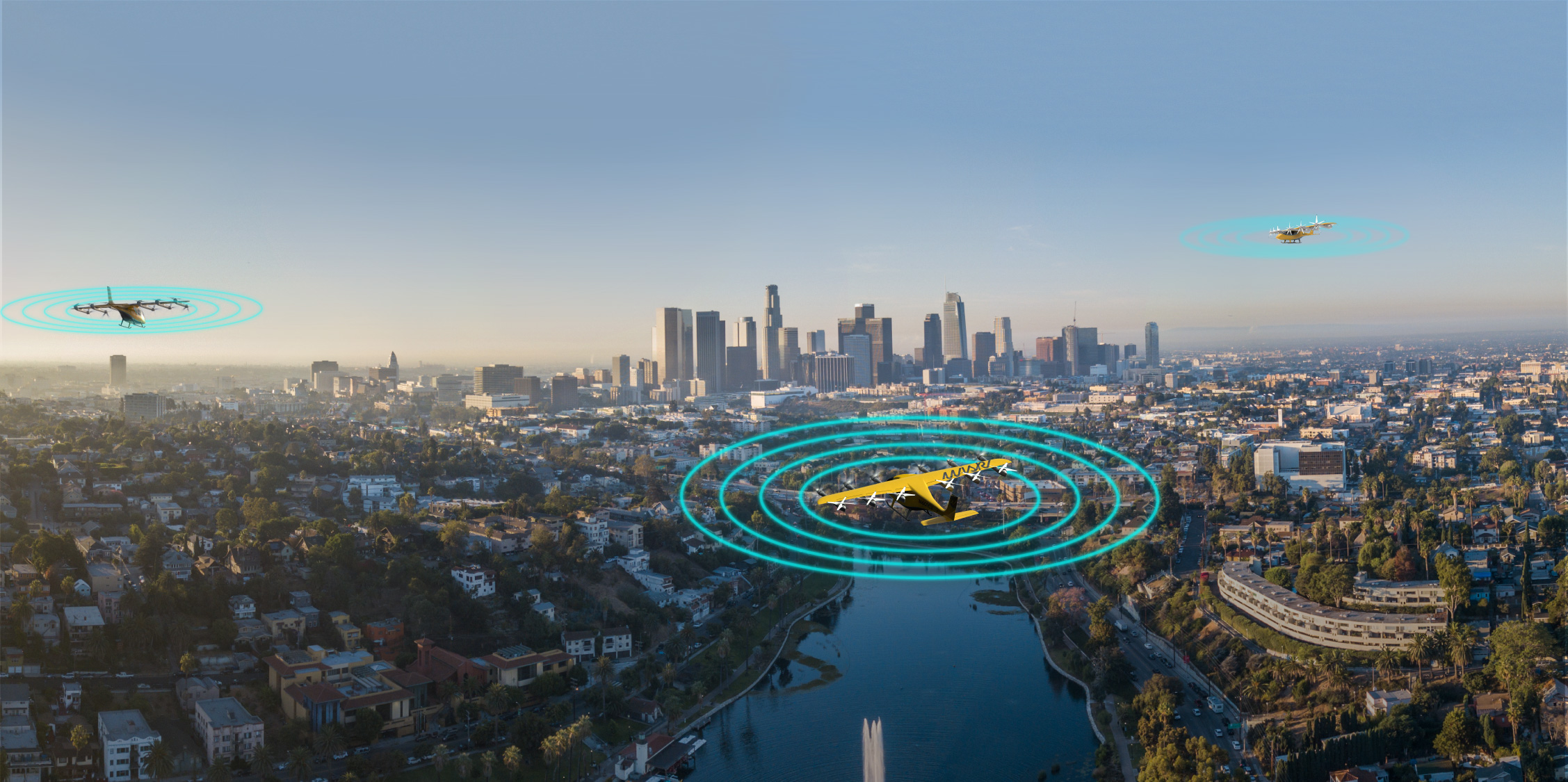
NASA eyes solar-powered fixed-wing electric vertical-takeoff-and-landing aircraft to explore Mars.
Maggie May Fly on Mars
A mission to explore Mars with a solar-powered fixed-wing aircraft that is able to take off and land vertically as well as fly long distances is to be studied under a contract awarded by the NASA Innovative Advanced Concepts program.
Miami-based startup CoFlow Jet has received a grant to study the Mars Aerial and Ground Intelligent Explorer (Maggie), a tandem-wing uncrewed aircraft that would be able to fly up to 179 km (111 mi.) on a fully charged battery every 7.9 Martian days. Total range per Martian year is 16,048 km.
Vertical-takeoff-and-landing (VTOL) capability is enabled by the startup’s eponymous CoFlow Jet (CFJ) active flow-control technology, developed by founder Gecheng Zha at the University of Miami, where he is a professor.
In the CFJ concept, a small amount of air is sucked into the wing airfoil at the trailing edge, pressurized by a microcompressor inside the airfoil and injected tangentially into the flow over the airfoil near the leading edge. This enables extremely high maximum lift coefficients.
In the company’s VTOL concept, the slipstream from multiple propellers on the leading edges of the tandem wings is turned vertically downward to convert all of the thrust into vertical lift—the 90-deg. turn in the airflow enabled by CFJ flow control over the flaps.
“The cruise Mach number of Maggie is 0.25 with a cruise lift coefficient of 3.5, nearly an order of magnitude higher than conventional aircraft to overcome the low density of the Martian atmosphere,” NASA says.
The ultrahigh lift coefficient and the ratio of lift-to-drag coefficients in cruise of 9 are made possible by CFJ, which overcomes the low Reynolds number effect on Mars. Reynolds number is used to predict flow patterns and at low atmospheric densities and low Reynolds numbers the aerodynamic performance of airfoil sections drops.
Cruising at an altitude of 1,000 m (3,300 ft.), Maggie is designed to conduct three atmospheric and geophysical investigations. One is a study of the origin and timing of the Martian core dynamo from the weak magnetic fields found in large impact basins. Mars is believed to have had a geomagnetic field driven by a core dynamo similar to Earth’s, but it shut down.
The other potential science missions for Maggie are a regional investigation of the source of methane signals detected by the NASA Curiosity Mars rover in Gale Crater and the high-resolution mapping of subsurface ice in the mid latitudes, which has been observed from orbit.
“The conceptual Maggie system study indicates that the concept appears to be feasible, but needs to be further investigated, designed and verified under Martian conditions in Phase 1,” NASA says.
AVIC Flies Electric Light Aircraft

The general aviation subsidiary of China’s AVIC flew the AG60E electric light aircraft for the first time on Jan. 3 at Jiande Qiandao Lake General Airport in Zhejiang province.
The two-seater is an electrified development of China Aviation Industry General Aircraft (CAIGA’s) AG60 light sport aircraft (LSA). The AG60 first flew in October 2020 and received an LSA type certificate from the Civil Aviation Administration of China in August 2021. CAIGA also produces the smaller AG50 LSA.
The AG60E is not China’s first electric light aircraft. Shenyang-based Liaoning General Aviation Academy (LGAA) received Chinese type certification for the 600-kg (1,320 lb.) RX1E electric LSA in 2015. LGAA is now developing the four-seat RX4E, which made its first flight in October 2019.
The RX4E is the first electric aircraft to be submitted for certification under CCAR-23, China’s equivalent to FAA Part 23 for general aviation aircraft. With a 1,200-kg maximum takeoff weight, the RX4E has a flight endurance of 1.5 hr. and range of 300 km (186 mi.) at a 200 kph (124 mph) cruise speed.
Separately, Yitong UAV System has begun production of the TP500 large uncrewed cargo aircraft, developed jointly with AVIC’s First Aircraft Institute. Based in Yantai, Shandong, the company has orders for 216 aircraft from eight customers including 30 for Chinese package carrier ZTO Express.
Powered by a piston engine, the 1,400-kg TP500 is designed to carry a 500-kg payload 500 km. AVIC First Aircraft Institute and Yitong have now launched development of the TP2000, a larger uncrewed cargo aircraft designed to carry 2,000 kg of payload 2,000 km. First flight is planned for 2025.
Lithium-Metal Batteries Aimed at UAM

U.S. battery startup SES AI is targeting the urban air mobility with its lithium-metal cells, beginning with drones but targeting full-size crewed aircraft in the longer term.
“Urban air mobility [UAM] is a perfect fit for lithium metal. For anything that flies, weight is really important, and lithium metal has one of the highest energy densities in watts per kilogram of any battery chemistry,” SES founder and CEO Qichao Hu said at the company’s Battery World 2023 event in December.
Boston-based SES is targeting the UAM market after entering into the industry’s first B-sample joint development agreement with a major automaker. In electric vehicle (EV) terms, B-sample is the first stage of production, where cells are produced in the thousands for use in module and pack development.
At Battery World, Hu presented data from a recent cycling test. “We charge the cell using C/3, a 3-hr. charge, and we discharge the cell using a typical UAM mission profile, and we achieve more than 1,500 cycles,” Hu says. “This is a game-changer for UAM.” Advanced energy-dense cells, including earlier lithium-metal chemistry, typically have short cycle lives.
SES has developed a large-format 100 amp-hour cell for EVs and electric vertical-takeoff-and-landing (eVTOL) applications. The cell has an energy density approaching 400 Wh/kg, higher than the 300 Wh/kg now achieved by lithium-ion cells.
The development of lithium-metal batteries has been hindered by the tendency for lithium dendrites, or spikes, to form and cause short circuits and thermal runaways. SES has developed a hybrid lithium-metal design that uses a solvent-in-salt liquid electrolyte and composite lithium-metal anode that change the way lithium dendrites form and grow.
“Our goal all along has been to improve safety without any compromises to other parameters,” Hu told analysts during a November earnings call. “We start with a high-energy-density approach that has inherently higher safety risk than a lower energy density, and we make it safe.”
That level of practical safety had to be demonstrated to qualify B-sample cells for supply to automakers, Hu told analysts, a milestone leading to the signing of the first joint development agreement. “We are now able to delay the thermal runaway onset temperature and reduce peak temperature and pressure during thermal runaway,” he said.
“UAM for us is not just another market; it is our destiny,” Hu said. SES plans to approach the market in three phases. First is small drones; second, full-size uncrewed aircraft; and third, full-size crewed aircraft. “Our goal is to use these aircraft to field-test our A-sample and B-sample lithium-metal cells for UAM applications.” SES’ A-sample cells have already been tested in drones in South Korea.
SES is producing 1,000 A-sample prototype 100 amp-hour cells a month on its line in Chungju, South Korea, and, in addition to three A-sample lines, two B-sample lines—one for EV applications and one for UAM—are planned to become operational in 2024 to build batteries for OEM testing.
“In B-sample, we are going to build about 5-10 cars’ worth of batteries,” he told analysts. “But 10 cars’ worth of batteries, that’s five eVTOLs’ worth of batteries. And if we supply five eVTOLs’ worth of batteries to the likes of Joby and Archer . . . then that’s considered commercial. The volume is smaller, but the margin . . . is much more favorable.”
In addition to the performance of its lithium-metal cells, Hu said an attraction of the UAM market is the lack of serious competition. “Most large-battery companies are so focused on land EV they think UAM is too small and not important to the business. That’s where we come in. It’s our chance to set industry standards for lithium metal,” he said.
Wisk Revises Autonomous UAM ConOps

Wisk Aero has updated its concept of operations for autonomous urban air taxis, moving from end-to-end trajectory-based operations to a procedural methodology for integration into national airspace that does not require changes to existing air traffic management systems.
The Boeing-owned eVTOL developer released the first version of its Concept of Operations (ConOps) for Uncrewed Urban Air Mobility in September 2022. The new version incorporates feedback from industry and government and changes to align with the FAA’s UAM ConOps V2.0 released in April 2023.
The ConOps targets safe initiation of uncrewed UAM passenger operations in U.S. airspace by the end of the decade. The document outlines Wisk’s approach to autonomous UAM aircraft, ground-based multivehicle supervisors in fleet operations centers supported by third-party service providers (TSP) and normal operations that rely mostly on existing traffic management concepts.
The updated ConOps is focused in mid-term UAM, defined as 2028-32, when uncrewed flights are conducted under expanded visual and instrument flight rules (IFR) that leverage Letters of Agreement with air traffic control (ATC) that enable more automated communications, as well as waivers, exemptions and other special procedures.
The first version of the ConOps called for trajectory-based flight plans to provide flow management as an enabler for uncrewed UAM. “UAM missions will use a single, comprehensive 4D trajectory that will include projected time slots for passing the planned waypoints and appropriate time tolerances,” the document said.
The updated ConOps says UAM-centric flight plans will provide flow management on UAM required navigation performance (RNP) routes. “A robust UAM RNP route network and pre-negotiated Letters of Agreement with ATC will preclude most routine ATC interventions in UAM flights, enabling ATC to manage UAM aircraft by exception rather than routine instruction,” the document says.
“While UAM operations may significantly benefit from the application of 4D trajectory projections to their flight plans, this concept is likely to be applied during the mature term, when TSPs take on increased levels of responsibility for airspace separation management,” the latest ConOps says.
“Management by exception is used as the transition stage to the TSP-managed environment where legacy ATC is not expected to manage UAM traffic,” the updated document says. “Under this ConOps, UAM RNP routes are assumed to be a transition stage between the regular IFR routes and TSP-management environment.”
“This ConOps defines our vision for autonomous advanced air mobility operations and the addition of uncrewed aircraft into the current aviation ecosystem,” says Wisk CEO Brian Yutko, adding that the document “provides a template for safe, everyday, autonomous flight.”





